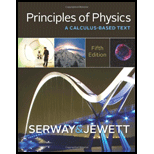
(a)
The number of components and the wavelength of each components.
(a)
Answer to Problem 56P
The numbers of components are
The wavelengths of each component are
Explanation of Solution
Write the expression for the separation distance.
Here,
Write the expression for the used wavelength.
Here,
Rewrite the expression (I) in terms of the number of components by using (II).
Rewrite the equation (I) in terms of wavelength.
Conclusion:
Substitute,
Hence, the number of components will be 1110100, 1110101, 1110102, 1110103 and so on.
For the first wavelength:
Substitute,
For the second wavelength:
Substitute,
For the third wavelength:
Substitute,
For the fourth wavelength:
Substitute,
Hence only first three wavelengths are possible.
Thus, the numbers of components are only three and the wavelengths of each components are
(b)
The root mean square speed for neon atom.
(b)
Answer to Problem 56P
The root mean square speed for neon atom is
Explanation of Solution
Write the expression for the root mean square speed by using conservation of energy.
Here,
Conclusion:
Substitute,
Thus, the root mean square speed for neon atom is
(c)
Whether the Doppler Effect for light emission by moving neon atoms should realistically make the bandwidth of the light amplifier larger than the 0.00140nm at
(c)
Answer to Problem 56P
The Doppler Effect for light emission by moving neon atoms should realistically make the bandwidth of the light amplifier larger than the 0.00140nm at
Explanation of Solution
Write the expression for the frequency from Doppler Effect.
Here,
Since, the frequency and the wavelength is inversely proportional, the apparent wavelength equation can be calculated by using equation (VI).
Write the expression for the apparent wavelength by using (II).
Here,
Conclusion:
Substitute,
The calculated wavelength is beyond limit. There will be many atoms which are moving more than rms speed. Hence, it can be expected that there will be more Doppler broadening of the resonance amplification peak.
Want to see more full solutions like this?
Chapter 24 Solutions
Bundle: Principles of Physics: A Calculus-Based Text, 5th + WebAssign Printed Access Card for Serway/Jewett's Principles of Physics: A Calculus-Based Text, 5th Edition, Multi-Term
- Figure P24.13 shows a plane electromagnetic sinusoidal wave propagating in the x direction. Suppose the wavelength is 50.0 m and the electric field vibrates in the xy plane with an amplitude of 22.0 V/m. Calculate (a) the frequency of the wave and (b) the magnetic field B when the electric field has its maximum value in the negative y direction. (c) Write an expression for B with the correct unit vector, with numerical values for Bmax, k, and , and with its magnitude in the form B=Bmaxcos(kxt) Figure P24.13 Problems 13 and 64.arrow_forwardCan the human body detect electromagnetic radiation that is outside the visible region of the spectrum?arrow_forwardAn industrial laser is used to burn a hole through a piece of metal. The average intensity of the light is 1.30×1091.30×109 W/m². What is the rms value of the electric field in the electromagnetic wave emitted by the laser?arrow_forward
- A future space station in orbit about the earth is being powered by an electromagnetic beam from the earth. The beam has a cross-sectional area of 106 m2 and transmits an average power of 2.00 × 104 W. What are the rms values of the (a) electric and (b) magnetic fields?arrow_forwardThe figure below shows a plane electromagnetic sinusoidal wave propagating in the x direction. Suppose the wavelength is 47.0 m and the electric field vibrates in the xy plane with an amplitude of 23.0 V/m. Calculate the frequency of the wave. Calculate the magnetic field vector B when the electric field has its maximum value in the negative y direction. Write an expression for vector B with the correct unit vector, with numerical values for Bmax, k, and ?, and with its magnitude in the form B= Bmax cos (kx − ?t).arrow_forwardWhat is the wavespeed of a wave of visible light traveling through a vacuum with with a wavelength of 400 nm and a frequency of 400 terahertz traveling through and electromagnetic field?arrow_forward
- what is the pressure that a sinusoidal plane Electromagnetic wave would exert on a absorbing surface if its magnetic field is 0.123 millitesla.arrow_forwardThe intensity of a polarized electromagnetic wave is 10 W/m2. What will be the intensity after passing through a polarizing filter whose axis makes the following angles with the plane of polarization? (a) θ = 0°, (b) θ = 30°, (c) θ = 45°, (d) θ = 60°, (e) θ = 90°.arrow_forwardA particular plane polarized electromagnetic wave, with a frequency of 100 MHz, is traveling through a vacuum in a direction we can call the x-axis. At t = 0, the electric field due to this wave at x = 0 has a magnitude of 300 V/m. What is the wavelength of this wave?arrow_forward
 Physics for Scientists and EngineersPhysicsISBN:9781337553278Author:Raymond A. Serway, John W. JewettPublisher:Cengage Learning
Physics for Scientists and EngineersPhysicsISBN:9781337553278Author:Raymond A. Serway, John W. JewettPublisher:Cengage Learning Physics for Scientists and Engineers with Modern ...PhysicsISBN:9781337553292Author:Raymond A. Serway, John W. JewettPublisher:Cengage Learning
Physics for Scientists and Engineers with Modern ...PhysicsISBN:9781337553292Author:Raymond A. Serway, John W. JewettPublisher:Cengage Learning Principles of Physics: A Calculus-Based TextPhysicsISBN:9781133104261Author:Raymond A. Serway, John W. JewettPublisher:Cengage Learning
Principles of Physics: A Calculus-Based TextPhysicsISBN:9781133104261Author:Raymond A. Serway, John W. JewettPublisher:Cengage Learning Physics for Scientists and Engineers: Foundations...PhysicsISBN:9781133939146Author:Katz, Debora M.Publisher:Cengage Learning
Physics for Scientists and Engineers: Foundations...PhysicsISBN:9781133939146Author:Katz, Debora M.Publisher:Cengage Learning




